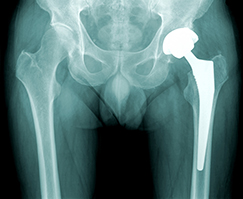
Total Knee Replacement ( TKR ) surgery is a technique that removes a diseased knee joint and replaces it with a prosthesis (artificial joint). A surgeon cuts away damaged bone and cartilage from your thighbone, shinbone and kneecap, and replaces it with an artificial joint (prosthesis) made of metal alloys, high-grade plastics and polymers. Depending on the condition of the cartilage on the undersurface of the kneecap, this may also be replaced. The actual procedure takes about 1 ½ to 2 hours.
Knee replacement surgery is also known as total knee arthroplasty.
Essentially, there are two main types of artificial knee replacements that are in common use:
• Cemented Prosthesis
• Uncemented Prosthesis
Your age and lifestyle as well as the surgeon’s experience will determine the choice between a cemented or uncemented prosthesis.
Studies show that knee replacement implants function well in 90-95% of patients, even 10 to15 years after surgery. In fact, most knee replacements last more than 20 years and many will last much longer.
Hip replacement surgery involves the replacement of the femoral head — the "ball" of the thighbone — with a metal ball and stem.
Hip implants come in a range of materials: a combination of durable, wear-resistant plastic and metals, including stainless steel and titanium. All these materials are designed to be accepted by the body. They are also resistant to corrosion and wear & tear.
The most widely used implant features a metal stem and a metal cup, with a plastic spacer in between. These implants have a well documented success rate, with over 90% functioning well after 10 years and 80% after 20 years.
The actual procedure takes about 2 hours
Traditional hip replacement requires the removal of a significant quantum of bone mass - the head of the femur (the bone in the upper leg) to replace it with an artificial ball.
Hip resurfacing is a more conservative surgical procedure which shields these worn ball-and-socket surfaces in the hip joint with smooth, durable metal components. By conserving more bone mass, younger patients retain the option of a traditional hip replacement procedure, if later needed.
The most popular hip resurfacing system is the Birmingham Hip Resurfacing system The Birmingham Hip has two main parts, both of which are made of metal, normally, high-carbide cobalt chrome.
A metal cap that is placed over the resurfaced femoral ball and the ball of the femur which is resurfaced before the metal cap is placed over it.
Arthroscopy is a surgical procedure which is used to visualize, diagnose and treat problems within a joint. A small incision is made and a pencil-sized instrument, called the arthroscope is inserted. The arthroscope contains a small lens and illumination system that magnifies the structures inside the joint. Thus the surgeon is able to see the interior of the joint through a small incision. He is also able to evaluate the type and extent of injury, and then correct the problem. The joints that are treated most frequently with this instrument are the knee, elbow, hip, shoulder, wrist and ankle. Some of the most commonly done procedures using arthroscopy:
• Repair or resection of torn cartilage (meniscus) from knee or shoulder
• Repair of torn ligaments
• Reconstruction of anterior cruciate ligament in knee
• Rotator cuff procedure
• Removal of inflamed lining (synovium) in knee, shoulder, elbow, wrist, ankle
• Release of carpal tunnel
• Removal of loose bone or cartilage in knee, shoulder, elbow, ankle, wrist
Ligaments are strong, non-elastic connective tissues that encase a joint.
The anterior cruciate ligament (ACL) is a key stabilizing ligament in the knee. Injury is by way of a sprain or a tear.
The posterior cruciate ligament (PCL) is located in the rear of the knee and connects the thighbone to the shinbone to prevent the shinbone from moving too far backward
A tear of the ligament can be partial or complete and can lead to destabilization of the knee. In some cases the ligaments and meniscii are damaged at the same time. The extent of injury depends on the direction and severity of the injuring force.
Arthroscopic surgery, which is minimally invasive and uses pencil-sized instruments, is used to determine and repair damage to the cartilage in the knee.
The damaged ACL is replaced with strong, healthy tissue taken from another area near the knee. Tendon from under the kneecap (patellar tendon) or hamstring may be used. The tissue is wired through the inside of your knee joint and Is attached to the ends to the thighbone and shinbone.
If the PCL is completely torn, it may be reconstructed using a portion of the patellar tendon or some other autograph.
World class affordable medical treatment in India.
Contact us